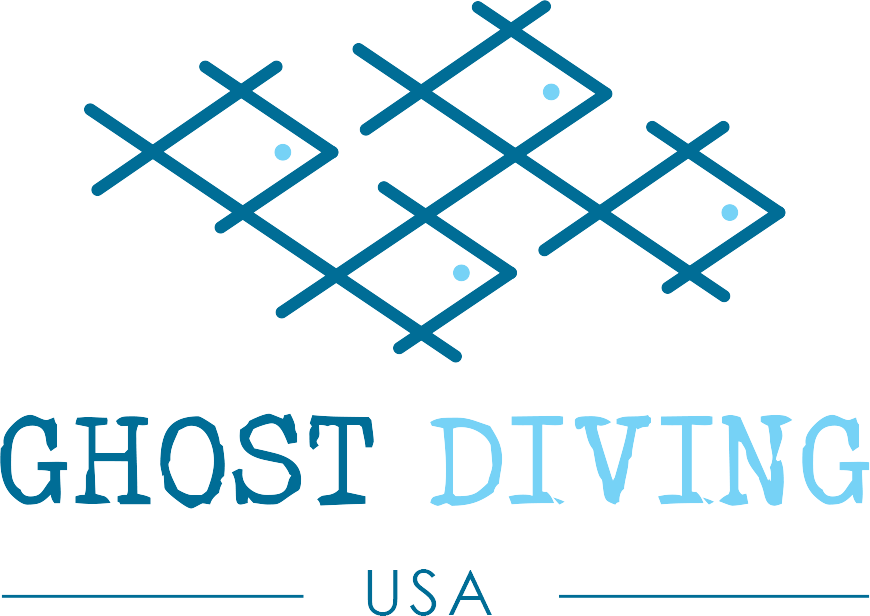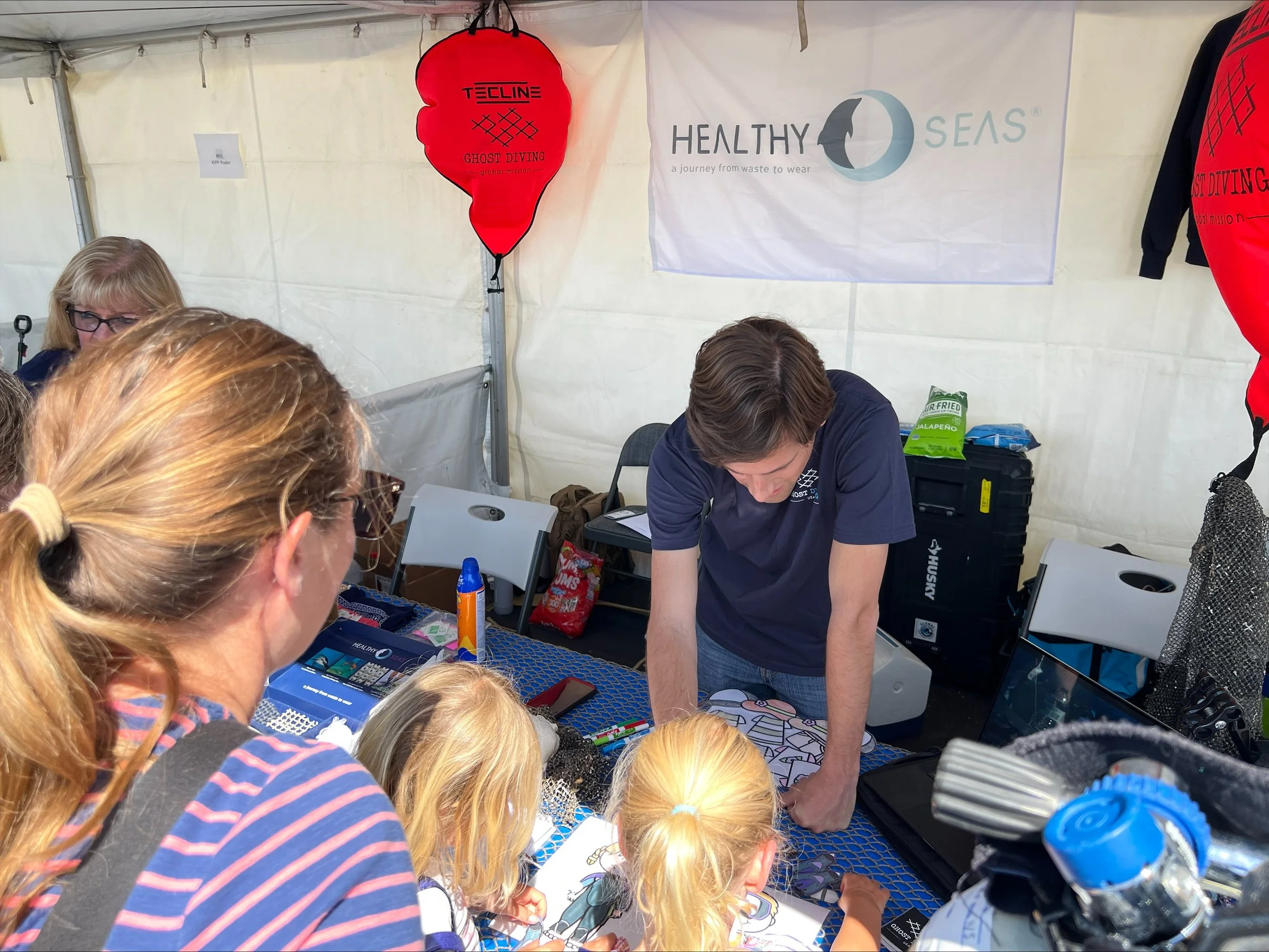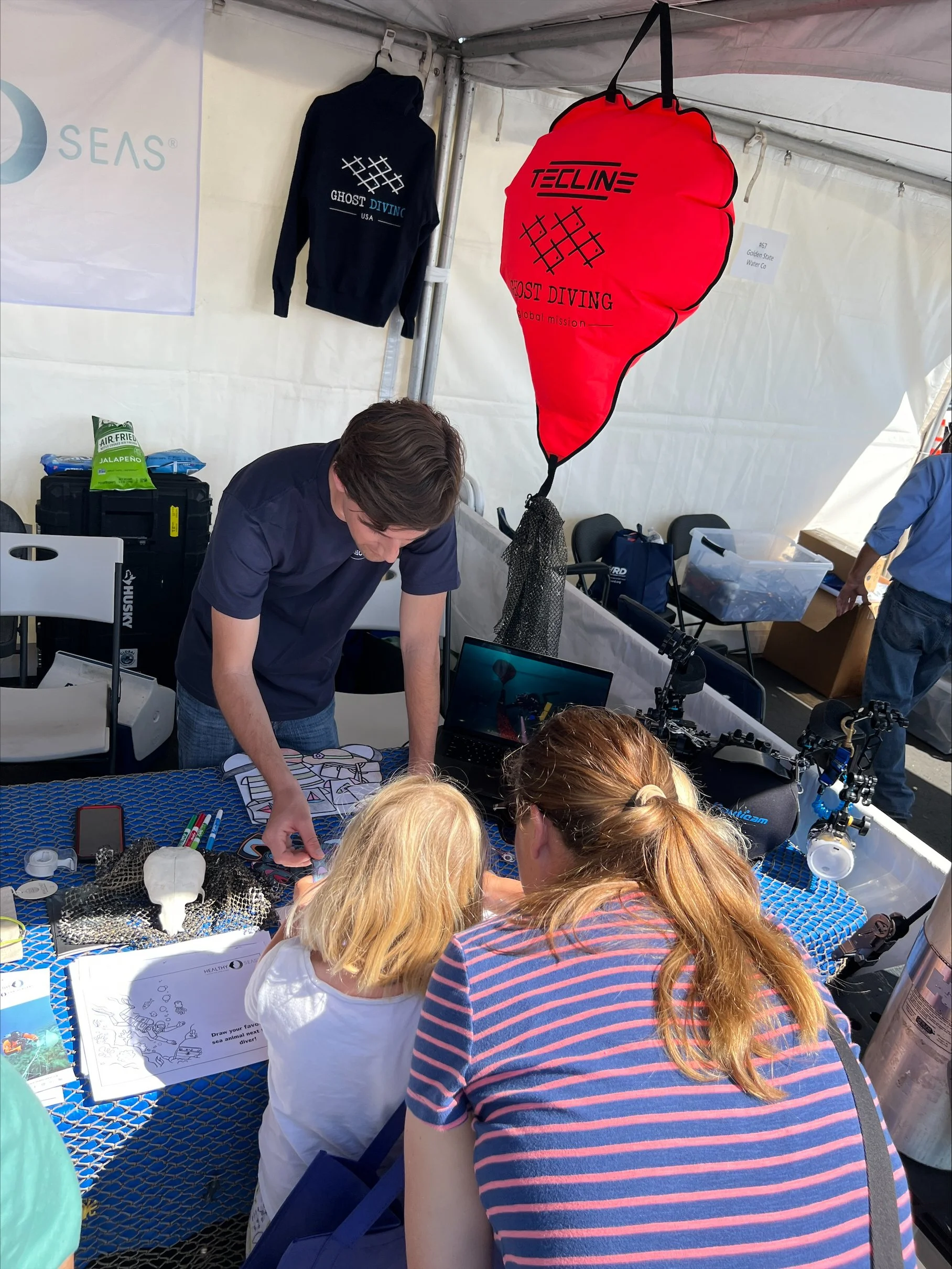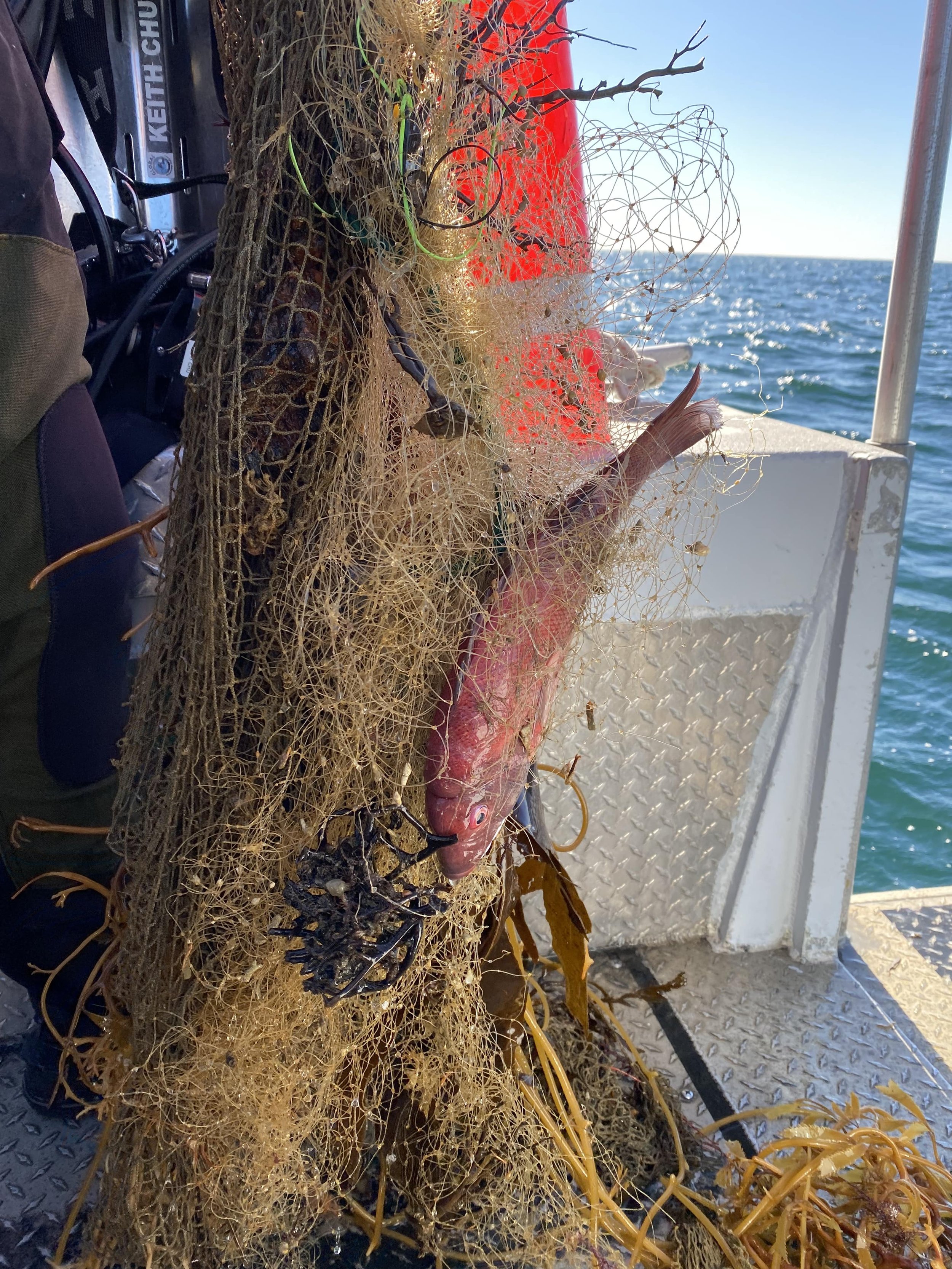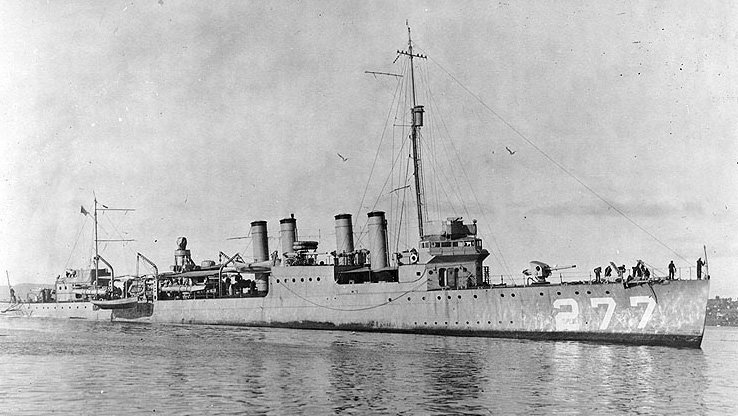Arrow Point
Location: Santa Catalina Island
Dive 1 Teams:
Team 1: Jim Babor, Karim Hamza, Shane McWilliams (Survey)
Team 2: Kian Farin, Daniel Pio (Documentation)
Dive 2 Teams:
Team 1: Jim Babor, Karim Hamza
Team 2: Kian Farin, Shane McWilliams
Team 3: Daniel Pio, Nicole Coleman
Mission Impact: GPS data collected for future clean up, 1 lobster trap removed, 1 lift bag recovered.
Team Ghost Diving USA set out aboard the Giant Stride for a survey mission at Arrow Point. The primary objective for the first dive was to collect GPS and depth data for lobster traps that were previously reported to be there by a few team members. The secondary objective was to bring up one lobster trap to gain insight into logistics for future clean up missions.
As the teams descended, they saw one cage trap at 110 feet and upon arrival at 150 feet they found a series a lobster traps daisy chained together. After finding one end of the line, the team cut one pot off, attached a lift bag and sent it to the surface. At this point, the teams split. Jim and Karim split from the group and followed the rope attached to the pots. Between 150 feet and 243 feet there was one very dilapidated cage trap that is currently unable to catch anything. Jim and Karim continued to follow the line and found the end with a lobster trap at 243 feet. The first dive was successful, all objectives were met. The teams completed their decompression obligations, a 90-minute surface interval, and headed off to the Tuna Clipper.
The second objective of the day was to recover 2 lift bags previously left behind on the Tuna Clipper. Team 3, Daniel and Nicole opted for a recreational dive against Catalina Island. Jim and Karim descended first. They set out to locate and recover the lift bags. Upon arrival, Jim and Karim found that there was only 1 lift bag left. They believe that, because the other lift bag was attached to a portion of net that was also attached to chain, the other bag ripped off. After 10 minutes, Kian and Shane met Jim and Karim. The teams set off in search of a section of net that is buried in the sand. The team, disoriented by the stunning visibility, took a slightly different directional heading away from the wreck and did not end up finding the net in the sand. The teams left the wreck. Upon getting back on the boat, the team celebrated a successful day of diving and exquisite conditions with food, naps, and a smooth crossing home.

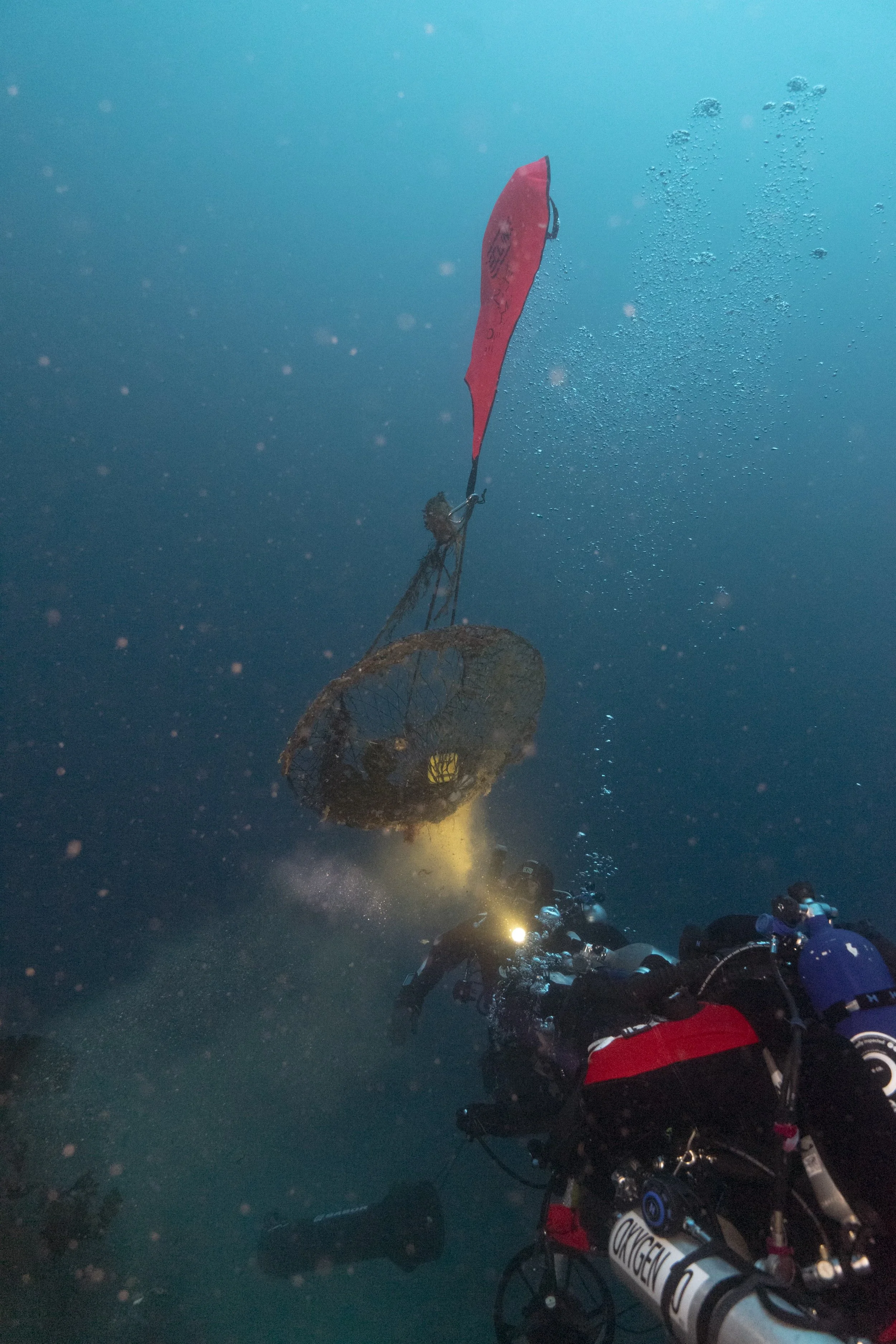



Tuna Clipper
Location: Santa Catalina Island
Wreck: The San Vito aka the Tuna Clipper
Net Handling Team 1: Jim Babor and Karim Hamza
Net Handling Team 2: Tianyi Lu and Nir Maimon
Documentation Team: Simeon Delikaris Manias and Mark Self
Team Ghost Diving USA returned to the Tuna Clipper on May 29th. There were multiple objectives for this mission. The first, to collect the rest of the net needed for the Beam Center playground equipment project. Next, recover a lift bag left behind on the last trip to the Tuna Clipper. Net handling team 1, Jim and Karim, were focused on the outer edge of the wreck where there is a significant amount of net buried in the sand. Net handling team 2, Tianyi and Nir, were focusing on other portions of the net closure to the wreck.






Our team did face some challenges. 2 lift bags were attached and then ripped off the net once they were inflated. Tianyi and Nir found a section of net that was attached to a significant amount of chain. The problem with this chain is that, due to the weight, the lift bags struggle to lift the chain to the surface. The team will have to return to address the portions of net that are attached to chain.
Of particular interest, the team found a very grim reminder of why our work is important. Amongst the net, divers found a skull. It was later determined that the skull belonged to a dolphin. The team was able to document and recover the skull. Heal the Planet (2021) estimated that approximately 650,000 whales, dolphins, seals, and other marine animals die as a result of fishing gear. Sadly, the team was again visited by this reality.
Earth Day
Earth Day was a busy and exciting day for Team Ghost Diving USA. We had the opportunity to do community outreach at 2 events. The first at the Los Angeles County Water District Headquarters in Whittier, California. The other at Pasadena ScienceFest held at John Muir High School in Pasadena, California. Both events were open to the public and anticipated around 2,000 attendees each.
Both events provided hands on learning activities for kids and educational materials related to our cause. Both teams enjoyed providing demonstrations of lift bag inflation and allowing people to try on recreational dive gear.
While we all love to get underwater and remove marine debris, we also love an opportunity to connect with the community and have conversations about why protecting the ocean is important.
The most frequently asked questions were about how people could get involved in our work. For those curious, there are a few ways:
Tell people about us. Share our social media channels, our website information, and our story. Scuba divers have the unique experience of seeing what is happening below the surface of the water. Without seeing the impact of abandoned fishing gear, it can be hard to understand the magnitude of the problem. This is why documentation is at the heart of our work. Through documentation, we can provide the evidence of the negative impact of marine debris and the positive results of our work.
Make sustainable choices. Choose products that are not single use, recycle, practice environmental mindfulness. While convenience can make life easier in the moment, it can have a lasting impact. Single use plastics, as an example, are non-biodegradable. This means that they become litter or sit in a landfill and pollute our environment. Choosing to use a reusable water bottle or reusable straws, for example, can help to reduce single use waste.
Be an informed consumer. Being an informed consumer allows you to make choices that reduce waste, conserve energy, avoid harmful substances, support sustainable practices, promote responsible waste management, and have a positive influence on the environment.
Whittier Team: Jim Babor, Norbert Lee, Curtis Wolfslau and Healthy Seas volunteers, Alisa and Julie.
Pasadena Team: Alex Caillat, Karim Hamza and Katie McWilliams.
The Jenny Lynne
Location: Rancho Palos Verdes Peninsula near Terranea Resort, California
Wreck: The Jenny Lynne
Net Handling Team 1: Jim Babor & Karim Hamza
Net Handling Team 2: Norbert Lee & Shane McWilliams
Documentation Team: Daniel Pio
Surface Support: Alex Caillat
Survey Team: Jim Babor, Karim Hamza, Shane McWilliams, Daniel Pio, Yury Velikanau, David Watson
The Jenny Lynne, pictured above, was a 66 feet long, 21.6 feet wide, 106 gross ton steel hulled fishing vessel built in 1972. On December 6, 2003, she was fishing for sardines and, for unknown reasons, starting taking on water. The crew was rescued by a local vessel, the San Pedro Pride. The Jenny Lynne came to rest in 150 feet of sea water with the highest point of the wreck sitting at 135 feet.
A survey the previous month found that there was a good amount of net on the bow, midship and on the seafloor around the wreck. The Ghost Diving USA documentation team took several images to facilitate the planning of the mission. Net Handling Team 1, Jim and Karim, worked on the midship section of the wreck and Net Handling Team 2, Norbert, Shane and Daniel, worked on the bow section of the wreck. Both teams successfully recovered a significant amount of net. Overall, a successful mission for team Ghost Diving USA!







Tuna Clipper
Location: Santa Catalina Island
Wreck: The San Vito aka the Tuna Clipper
Net Handling Team: Jim Babor and Karim Hamza
Documentation Team: Symeon Delikaris Manias and Curtis Wolfslau
Support Team: Mark Self
Ghost Diving USA continues their pursuit of ghost nets on the Tuna Clipper. On February 13, divers set out aboard the Giant Stride to collect more net for the Beam Center playground project. Conditions were less than generous to the team. The surface conditions were very rough, making the crossing to and from the dive site less than ideal. However, the team focused on the positives. They took a moment to celebrate Valentine’s Day with an early morning chocolate and got to work. The team deployed 4 lift bags which created a curtain of net. As the net handling team (Jim and Karim) was cutting through the net, it started to rise. Unfortunately, the lift bags ripped free of the net causing the net to fall back down. The teams persisted and were able to get one lift bag with net attached to the surface. The team ran out of bottom time and could not raise the final lift bag.
They completed the team completed their decompression along the slope of Catalina Island and enjoyed a little time on their scooters. When they got back to the boat, Captain Jim and Emma had collected the lift bags and net. Not every mission can go according to plan and conditions will not always be ideal. Team Ghost Diving USA is up for the challenge and looks forward to their next visit to the Tuna Clipper.
Tuna Clipper
Location: Santa Catalina Island
Date: January 28, 2023
Wreck: The San Vito aka the Tuna Clipper
Net Handling Team: Jim Babor and Karim Hamza
Documentation Team: Tianyi Liu
Support Team: Symeon Delikaris Manias
Team Ghost Diving USA set out on January 28th aboard the Giant Stride. Their goal was to start removing net off of the wreck of the San Vito aka the Tuna Clipper. The San Vito is an 85 foot vessel used to commercial tuna fishing out of San Pedro Harbor (L.A. Times Archives, 1985). The vessel crashed into some rocks due to poor visibility, capsized and ultimately sank at 12:30 am (L.A. Times Archives, 1985). The 12 crew members survived the incident by waiting for rescue in a small rowboat (L.A. Times Archives, 1985). The Tuna Clipper now rests in approximately 170 feet of water.
The Tuna Clipper wreck has been on the Ghost Diving team’s radar for a while. A few years ago, a documentation dive was completed. Photos and video were taken and showed that the wreck was covered in net. Jim estimates it will take approximately 2 years to clear the wreck of net. The team had a 2.5 hour boat ride to the wreck allowing the team to review the video from the original survey mission. They devised their plan, executed it and were well rewarded. They collected hundreds of pounds of net.
The net was recovered in 3 sections. The net will be sent to our partners for cleaning. One section will be sent to the Beam Center and pieces of the other 2 sections will be sent to artists who have requested it for their projects.
The Radio Tower
Location: Point Fermin, Rancho Palos Verdes Estates, California
Date: January 23, 2023
Net Handling Team: Jim Babor, Norbert Lee
Documentation Team: Keith Chu, Shane McWilliams
Observation and Training Team: Jamie Mitchell, Walter Zagzebski
The Radio Tower
Ghost Divers set out aboard the Giant Stride to clean up the Radio Tower. The Radio Tower has unknown origins but rests in 110 ft at the deepest portion of the structure. The shallowest portion of the structure sits in 85- 90 feet. A previous survey of the structure showed that nets were intertwined with various parts of the structure. This clean up presented some unique challenges because of how the net had become entangled in the structure.
The first piece of net recovered was at the shallower end of the structure. It was dangling vertically and still attached to a significant amount of line. This line added a level of complexity to the mission because in order to safely lift the first piece of net, the line had to be unraveled from the structure to ensure the net would lift without snagging. Thenet team worked diligently to ensure this was done with care.
The second section of net served as a grim reminder of why our mission is critically important. This second section of net, which was a thin monofilament net, had captured and claimed the life of a sheephead. California sheephead live around rocky reefs and kelp beds. The final piece of net recovered was a mesh net in the middle of the structure.
There is still work to be done at the Radio Tower. The team observed a hoop net and an additional smaller piece of net needing recovery. Unfortunately, the team did not have enough time to safely recover the nets. Their locations were noted for later recovery.
Abalone Cove
The second dive of the day was at Abalone Cove. The goal of the Abalone Cove dive was to find a net in approximately 30 feet of water. The intention is to use the net to provide net training for Ghost Divers. unfortunately, due to visibility at the site, the team was unable to locate the net. The team will return to Abalone Cove to search for the net and recover it for training.
The Beam Center
The nets recovered will be sent to the Beam Center in New York City. The Beam Center provides young adults with opportunities to collaborate with artists, engineers and various fabricators. Through this collaboration, the young adults build unique and innovative projects.
You can learn more by visiting the Beam Center website: https://beamcenter.org/
Farnsworth Bank and The Midnight Hour
Location: Farnsworth Bank & The Midnight Hour - Catalina Island
Date: October 10, 2022
Open Circuit Team: Norbert Lee, Rene Tetter, Curtis Wolfslau
Closed Circuit Team: Jim Babor, Karim Hamza, Tianyi Lu
The Goal
Team Ghost Diving USA set out to survey two targets: Farnsworth Bank and the wreck of the Midnight Hour. The objective of these surveys is to collect data and images that will help the teams evaluate the impact the net is having on the environment around it, the potential risks of removing the net and, ultimately, the logistics of removing the net.
Target #1 - Farnsworth Bank
Farnsworth Bank is a state marine conservation area (SMCA_ on the windward side of Catalina Island. As an SMCA, some recreational and commercial take is allowed with varying restrictions. Farnsworth Bank offers some of the most beautiful and unique diving that Catalina has to offer. The dive site is a series of pinnacles that range from approximately 60 - 150 feet in depth. Recreational and technical divers alike flock to Farnsworth Bank to experience the wide variety of unique marine flora and fauna. A 200 foot net was previously reported by Karim and Jim after they found a drowned cormorant in the net.
The teams descended on the middle pinnacle, called middle 68, to 143 feet and located the net. Upon arriving, the teams collected GPS data, survey notes and video of the net. the teams also found lobster traps and small pieces of net on top of a pinnacle at 90 feet. After a successful survey dive, the team moved to their next target: The Midnight Hour.
Target #2 - The Midnight Hour
The Midnight Hour is a commercial purse seiner that sank off the west end of Catalina on August 30, 2011. She is 61 feet long and resting on her starboard side at approximately 100 feet. The crew was rescued with no injuries or fatalities, but the cause of her sinking is unknown. The Ghost Diving team descended upon the wreck and found that the drum, which holds the majority of the net, has now separated from the wreck. The team collected data as well as video of the wreck and the drum. They feel that they, with appropriate planning, can successfully clean up the net. One of the most significant logistical factors will be conditions at the site of the wreck. It is well known that the site has strong currents and rough surface conditions. The team will have to plan conservatively.
The Moody
Location: San Pedro Bay, California
Wreck: The Moody
Date: September 10 & 17th, 2022
The Moody
The Moody is a Wickes class destroyer that is 314 feet long. She was commissioned in December 1919 and assigned to the pacific fleet. She was decommissioned in June 1930 and set for disassembly. In 1933 she was purchased by MGM for the movie “Hell Below”. The Moody was remade to look like a German destroyer. On February 21, 1933, crews detonated explosives between watertight compartments with the hope she would float after the explosion. Unfortunately, another series of explosions damaged the watertight compartments causing her to sink at 5:30 pm. She rests in approximately 150 feet of water. The two halves of the wreck are about 111 feet apart.
Californiawreckdivers.org (n.d.).
September 10, 2022
Survey Team: Jim Babor, Karim Hamza, David Watson
The survey team set out with the objective of collecting GPS data to pinpoint locations of the net on the wreck. The team found that there were 5 area of the wreck holding nets with a significant concentration of net being found at the stern Pictures, video and survey notes were collected.
September 17, 2022
The team returned to the Moody for a clean up mission.
Closed Circuit Team: Jim Babor, Karim Hamza, Nir Maimon
Open Circuit Team: Jung-han Hsieh, Norbert Lee, Mark Self
The teams agreed to take one half of the wreck each. The closed circuit team descended first to stage the lift bags for both teams and start working on their half of the wreck. The open circuit team descended upon the wreck and began removing net from their half. The teams planned a 2 hour dive and were excited to report that their dive was shorter than anticipated at an hour and 30 minutes. They attribute this efficiency to the use of the GPS data. They were able to plan their dives with a high level of precision because they knew exactly where to find the net. They were able to successfully remove the majority of the net from the wreck and plan to monitor the status of the remaining net.
